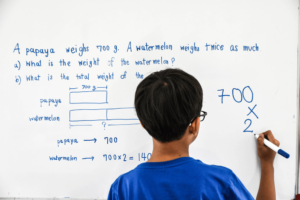Are you looking for strategies to help students who have trouble solving word problems? If so, keep reading.
1. Make sure that it is not a failure to read that is the cause of the learner’s difficulty solving math word problems.
2. Get the learner to read the word problem silently and then aloud. Get them to find the mathematical operation required.
3. Give short and concise word problems that require a one-step process.
4. Teach the learner clues or keywords to look for in word problems that indicate mathematical operations.
5. Get the learner to orally analyze the steps that are required to solve word problems (e.g., “What is given?” “What is asked?” “What operation(s) is used?” etc.).
6. Represent the numerical amounts presented in the word problems in concrete forms (e.g., problems involving money can be represented by providing the learner with an appropriate quantity of real or play money).
7. Get the learner to write a number sentence after reading a math word problem. (This process will help the learner see the mathematical relationship prior to discovering the answer.)
8. Get the learner to create word problems for number sentences. Put the number sentences on the smartboard and have the learner tell or write word problems that could be solved by the number sentence.
9. Get the learner to repeat math word problems in their own words.
10. Ask the learner to find the primary question that must be answered to solve a given word problem. Continue this learning experience using more complicated word problems containing two or more questions. Make sure the learner knows that questions are often implied rather than directly asked.
11. Get the learner to write word problems involving specific operations. Get other students in the classroom to solve these problems.
12. Supplement textbook problems with teacher-made problems that deal with classroom experiences and include students’ names to make them more realistic and essential to the learner.
13. Utilize word problems that are related to the learner’s experiences and are of interest to him/her.
14. Make sure the learner reads through the entire word problem before trying to solve it.
15. Teach the learner to break down each word problem into specific steps.
16. Get the learner to make notes to set the word problem up in written form as they read it.
17. Get the learner to simulate situations that relate to math word problems (e.g., trading, selling, buying, etc.).
18. Get the learner to solve word problems by manipulating objects and by stating the process(es) used.
19. Assist the learner in recognizing common patterns in word problems (e.g., how many, add or subtract, etc.).
20. Talk about words and phrases that usually indicate an addition operation (e.g., together, all together, sum, in all, both, gained, received, total, won, saved, etc.). Give the learner a list of those words and phrases.
21. Consider using Alexa for the Math Classroom.
22. Try gamifying your math lessons.
23. Consider using one of the apps and tools from our many math app lists:
9 Must-Have Apps and Tools for Kids Who Hate Math
10 Apps to Teach Preschoolers Math
20 Math Apps for Students of All Ages
Advanced Math Apps, Tools, and Resources for That We Love
Elementary School Math Apps, Tools, and Resources That We Love
Fraction Apps, Tools, and Resources That We Love
High School Math Apps, Tools, and Resources That We Love
Interactive Math for the Google Classroom
Math Apps, Tools, and Resources That I Would Use If I Were Still in the Classroom
Math Manipulatives Apps, Tools, and Resources That We Love
Middle School Math Apps, Tools, and Resources That We Love
Multiplication Apps, Tools, and Resources That We Love
PreK Math Apps, Tools, and Resources That We Love
YouTube Channels for the Math Classroom
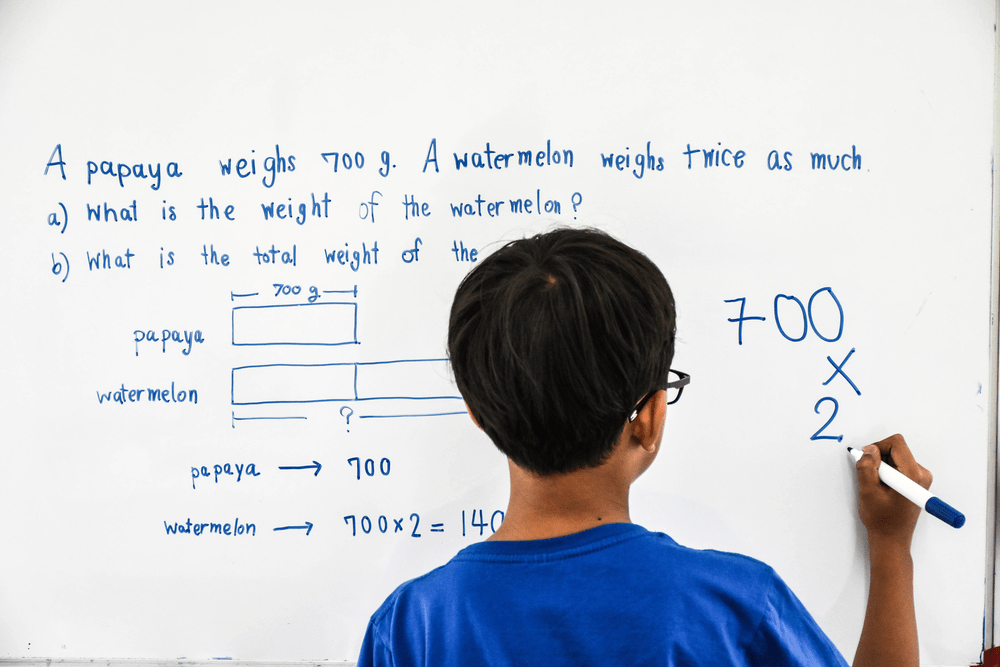
Contents
-
1. Why Your Kids Struggle With Math Word Problems
-
2. Help your child overcome the fear of word problems
Have you noticed that your child’s homework contains more word math problems than ever before? Math word problems are regarded as a vital part of the mathematics curriculum, as it enhances the student’s mental skills, helps develop logical analysis and boosts creative thinking. Learning to solve math word problems from a young age provides the foundation students need to solve similar problems when they enter the workplace.
However, word problems are hard. Word problems are confusing. And our kids hate doing word problems. Whether your child excels in math or struggles to understand mathematical concepts and formulas, math word problems are often an entirely new entity that can cause even mathematically skilled children to struggle. Math word problems require a different skill set than standard math problems that children will need to master in order to succeed. To get the right answer, your child has to be able to read the words, figure out what math operation to use, and then do the calculations correctly. A breakdown in any of these skills can lead to difficulty.
If your child seems to be good at math but has trouble with word problems, here are possible reasons why—and ways you can help.

Why Your Kids Struggle With Math Word Problems
Children often struggle with math word problems because they require an ability to analyze information and extract only useful elements. Instead of being told directly what operation they need to do, they have to discover it themselves before they can even begin to figure out the solution. Students struggle with math word problems for many reasons, but there are 3 main problems that we at Everest Education find many students have encountered:
#Reason1: Trouble With Reading
To solve word problems, children have to read well. One reason your child may be struggling is that she has trouble with reading in general. How do you know if this is a difficult area for them? Try reading a word problem to your child. If your child gets the correct answer when you read it aloud, but not when reading the problem on their own, it could be a challenge with reading.
#Reason2: Trouble Understanding Math Phrases and Concepts
Even if kids are strong readers, they may have trouble picking up on clues in word problems. These clues are phrases that help students figure out what they need to do to solve the problem. Kids must translate these phrases into what teachers call “a number sentence.” Here’s a simple example of a word problem and its corresponding number sentence:
- Word problem: “Sue has two pencils. She spends one hour at the store and buys three more pencils. How many pencils does Sue have in all?”
- Number sentence: “2 + 3 = ____.”
Some kids can picture a number sentence like this one in their heads. Others need to write it down. Either way, there’s a lot to think about before getting to the point where you can calculate that the answer is 5. To turn a word problem into a number sentence, kids need to understand the language and concepts of math. For example, they need to know that the phrase “How many pencils in all?” means adding together the two groups of pencils. Some kids have a lot of trouble with this skill. That’s why a child who can easily calculate 2 + 3 = 5 might struggle with a word problem using the same calculation.
#Reason3: Trouble With Focus and Self-Control
Some kids can read a word problem and explain how it should be solved, but still, get the wrong answer. What’s going on? One reason could be trouble with focus and self-control. Kids may get distracted by the words or get lost in their heads. This can lead to confusion with the math. Other kids struggle with self-control and rush through the problem. They may skip important parts or make simple calculation mistakes. Extra information in word problems can trip kids up, too. Some details aren’t needed to solve the problem. For example, kids don’t need to know that Sue spent one hour in the store to figure out how many pencils she has. Kids need to learn to weed out this information.
Where learning meets joy
with friends and teachers who care
Help your child overcome the fear of word problems
Math problems can be a struggle and helping kids understand them isn’t always easy. Here we suggest parents some simple ways to help your child tackle math word problems with ease:
1. Utilize math in everyday life
Your child’s math homework may have a problem that involves going to the grocery store and figuring out a total bill, or baking in the kitchen following a new recipe. Try recreating this in real life and help your child learn to use math in practical ways. You can also make a game of it and show your child that math can be fun!
>> Find out some playful Math activities to play with your primary kids at home to enhance math learning: https://blog.e2.com.vn/playful-math-activities-for-your-primary-kids/

If your child is struggling with math word problems, teach her a logical process to go through to determine what needs to be done. These steps should be:
- Question – Read the problem to determine what the question is.
- Information – Determine what information you have.
- Clue words – What words tell you the math process to use.
- Equation – Use the information, question and clue words to write an equation.
- Check your work – Does your answer make sense compared to the given information and the question?
Once your child can learn to use this process on a regular basis, you will find that she has much more success with word problems.
3. Teach your child common keywords
Many students read a word problem and have no idea what to do with it. Yet most word problems at primary grade levels have clue words in them. Helping your child understand which words are associated with different mathematical functions can help steer her in the right direction to find the final answer. For instance, “and” usually indicates an addition problem, while “less than” may clue you into a subtraction problem and “product of” means you’ll need to multiply. That’s why parents should teach your child to identify those clue words, to help ease the struggle. Here are the basic clue words:
- Addition – Combined, increased, a total of, sum, added to, together, plus
- Subtraction – Minus, less, less than, fewer than, difference, decreased, take away, more than
- Multiplication – Multiplied, the product of, times, of
- Division – Divided by, into, per, the quotient of, percent, out of, the ratio of
Parents can make index cards with phrases that are commonly used in word problems. For example, one index card might show “in all” next to the “+” sign. Another card might show “all together” next to the “+” sign. When your child works on math homework, encourage your child to get into the habit of matching an index card to each phrase in a word problem.
>> To help your child quickly get along with basic math terms in English, click here to download our free printable flashcards, created by Everest Education’s math teachers.
Download Math flashcards
4. Use Manipulates or Diagrams
Sometimes visualizing the problem can give the student the tools needed to solve it. For problems with small amounts, you can use math manipulatives to help your child picture what is happening. For larger amounts or measurements, draw a diagram. This action gets additional learning processes involved and helps make the word problem a visual concept for the child to consider. You can also ask kids to close their eyes and try to picture what’s happening in the problem: “Imagine the first group of pencils joining together with the second group and forming one large group.”
Make it more concrete by using coins, toothpicks, or other objects. Use them to form the two small groups, and then combine them into one group. This is also one of many useful techniques that our teachers often apply in our math classes, where we use manipulatives such as paper, coins, building blocks as tangible objects to introduce new concepts, help students approach and solve problems. The key to making word problems solvable for your child is to make them understandable and then provide the right practice and support.
5. Improve your child’s ability to focus
Ask your child to read through the problem once. Then, have your child read it again, circling the important words and phrases. This is called active reading. It can help your child stay focused and avoid rushing. Another strategy is using blank pieces of paper to cover all the problems except the one your child is doing. You can also try making a list of things for your child to double-check.
>> Additionally, parents can learn more about 3 Reasons Why Your Child Does Not Stay Focused In School, as well as find out some Expert Tips to Improve Your Child’s Focus in Class from our old articles. Once you’ve tried a few of these suggestions, you might have an idea why your child is struggling with math word problems.
6. Practice, practice, practice!
How can your child become a better problem-solver? By solving more problems, of course! In order for a child to gain mastery of word problems, she needs practice. To get your child comfortable with the process of solving math word problems, you and your child can talk through how to solve the problem before she attempts to find the answer. There are a number of websites that offer free sample problems for your child to tackle. If she needs additional help, you can come to visit us at Everest Education, where we help students strategize and solve equations with confidence. We offer a personalized Singapore math program covering all math topics, including word problems, and provide personalized instruction to ensure that students make adjustments as needed when practicing.
Word problems are a big change from traditional math problems, and they require a different set of skills that children may not have developed yet. It can be tricky, but by developing a process and practicing on a regular basis, word problems will no longer be difficult. We hope these exercises can help develop your child’s logical and abstract thinking skills as well as help them strengthen her problem-solving abilities.
Reference:
https://www.understood.org/en/learning-thinking-differences/child-learning-disabilities/math-issues/trouble-with-math-word-problems
http://www.sylvanlearning.com/blog/index.php/help-child-word-math-problems/
https://hellothinkster.com/blog/making-math-word-problems-accessible-for-fourth-graders/
Register For A Free Trial Class
Присоединяйтесь к Reverso, это удобно и бесплатно!
английский
арабский
немецкий
английский
испанский
французский
иврит
итальянский
японский
корейский
голландский
польский
португальский
румынский
русский
шведский
турецкий
украинский
китайский
Показать больше
(греческий, хинди, тайский, чешский…)
чешский
датский
греческий
фарси
хинди
венгерский
словацкий
тайский
Показать меньше
русский
Синонимы
арабский
немецкий
английский
испанский
французский
иврит
итальянский
японский
корейский
голландский
польский
португальский
румынский
русский
шведский
турецкий
украинский
китайский
Показать больше
чешский
датский
греческий
фарси
хинди
венгерский
словацкий
тайский
Показать меньше
На основании Вашего запроса эти примеры могут содержать грубую лексику.
На основании Вашего запроса эти примеры могут содержать разговорную лексику.
Does the child seem frustrated or embarrassed when he has trouble with a word?
Sometimes I have trouble with words, too.
Trouble with words and difficulty expressing oneself through speech (Aphasia)
Проблемы со словами и трудности, связанные с выражением себя через речь (афазия)
Our beautiful girl had trouble with words.
Результатов: 32447. Точных совпадений: 1. Затраченное время: 282 мс
Documents
Корпоративные решения
Спряжение
Синонимы
Корректор
Справка и о нас
Индекс слова: 1-300, 301-600, 601-900
Индекс выражения: 1-400, 401-800, 801-1200
Индекс фразы: 1-400, 401-800, 801-1200
© 2013-2022 Reverso Technologies Inc. Все права защищены.
Click here to see ALL problems on Miscellaneous Word Problems
| Question 265136: I have trouble with word problems,I don’t know where to begin. The problem is Plastics Unlimited plans to produce a one component vertical file by bending the long side of an 8-in. by 14-in. sheet of plastic along two lines to form a U shape. A. Express the volume of the file as a function of the height x, in inches, of the file. B. Find the domain of the function. Thank You for your help. (Scroll Down for Answer!) |
Did you know that Algebra.Com OR get immediate PAID help on: |
Answer by ankor@dixie-net.com(22713)

(Show Source):
You can put this solution on YOUR website!
produce a one component vertical file by bending the long side of an 8-in. by 14-in. sheet of plastic along two lines to form a U shape.
:
A. Express the volume of the file as a function of the height x, in inches, of the file.
Height is given as x, therefore the width = (14-2x): x|__|x is the shape
Vol = x*(14-2x)*8
V = (-2x^2 + 14x) * 8
V = -16x^2 + 112x
:
B. Find the domain of the function.
Looking at the expression (14-2x), the domain has to be >0 and <7
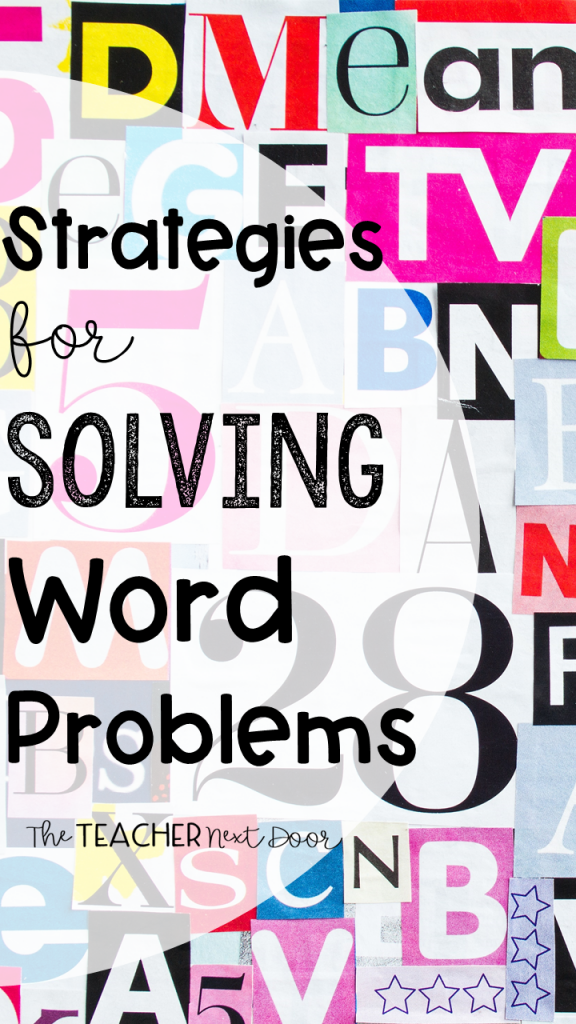
It’s one thing to solve a math equation when all of the numbers are given to you but with word problems, when you start adding reading to the mix, that’s when it gets especially tricky.
The simple addition of those words ramps up the difficulty (and sometimes the math anxiety) by about 100!
How can you help your students become confident word problem solvers? By teaching your students to solve word problems in a step by step, organized way, you will give them the tools they need to solve word problems in a much more effective way.
Here are the seven strategies I use to help students solve word problems.
1. Read the Entire Word Problem
Before students look for keywords and try to figure out what to do, they need to slow down a bit and read the whole word problem once (and even better, twice). This helps kids get the bigger picture to be able to understand it a little better too.
2. Think About the Word Problem
Students need to ask themselves three questions every time they are faced with a word problem. These questions will help them to set up a plan for solving the problem.
Here are the questions:
A. What exactly is the question?
What is the problem asking? Often times, curriculum writers include extra information in the problem for seemingly no good reason, except maybe to train kids to ignore that extraneous information (grrrr!). Students need to be able to stay focused, ignore those extra details, and find out what the real question is in a particular problem.
B. What do I need in order to find the answer?
Students need to narrow it down, even more, to figure out what is needed to solve the problem, whether it’s adding, subtracting, multiplying, dividing, or some combination of those. They’ll need a general idea of which information will be used (or not used) and what they’ll be doing.
This is where key words become very helpful. When students learn to recognize that certain words mean to add (like in all, altogether, combined), while others mean to subtract, multiply, or to divide, it helps them decide how to proceed a little better
Here’s a Key Words Chart I like to use for teaching word problems. The handout could be copied at a smaller size and glued into interactive math notebooks. It could be placed in math folders or in binders under the math section if your students use binders.
One year I made huge math signs (addition, subtraction, multiplication, and divide symbols) and wrote the keywords around the symbols. These served as a permanent reminder of keywords for word problems in the classroom.
If you’d like to download this FREE Key Words handout, click here:
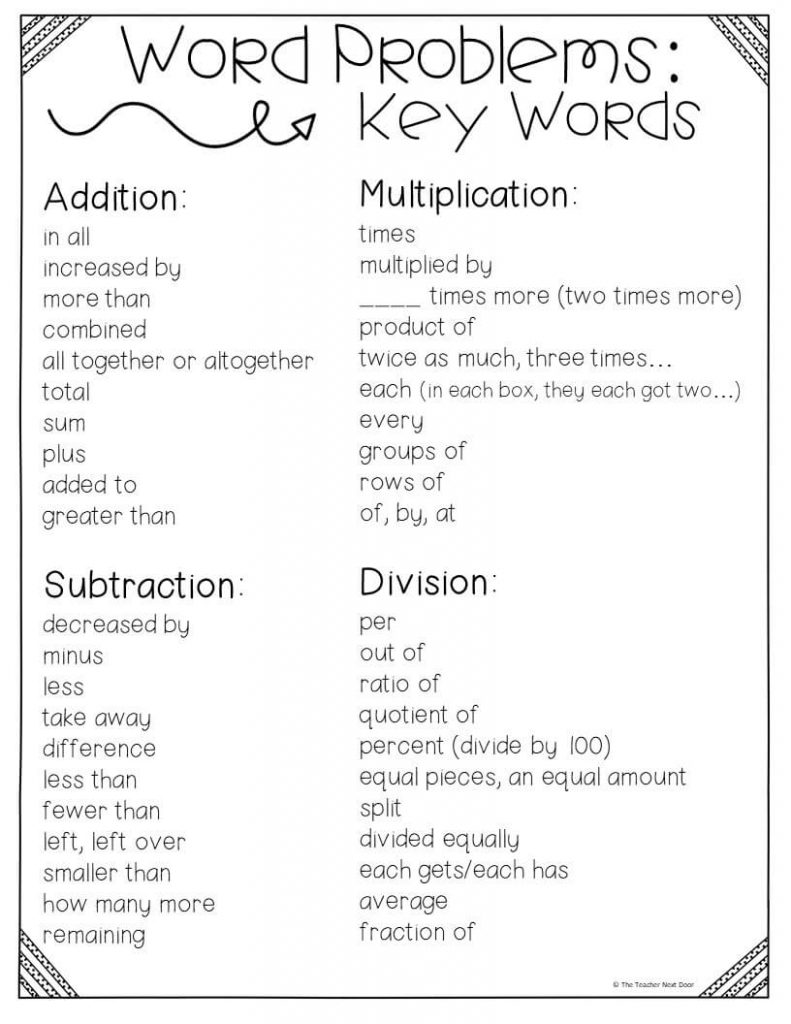
C. What information do I already have?
This is where students will focus in on the numbers which will be used to solve the problem.
3. Write on the Word Problem
This step reinforces the thinking which took place in step number two. Students use a pencil or colored pencils to notate information on worksheets (not books of course, unless they’re consumable). There are lots of ways to do this, but here’s what I like to do:
- Circle any numbers you’ll use.
- Lightly cross out any information you don’t need.
- Underline the phrase or sentence which tells exactly what you’ll need to find.
4. Draw a Simple Picture and Label It
Drawing pictures using simple shapes like squares, circles, and rectangles help students visualize problems. Adding numbers or names as labels help too.
For example, if the word problem says that there were five boxes and each box had 4 apples in it, kids can draw five squares with the number four in each square. Instantly, kids can see the answer so much more easily!
5. Estimate the Answer Before Solving
Having a general idea of a ballpark answer for the problem lets students know if their actual answer is reasonable or not. This quick, rough estimate is a good math habit to get into. It helps students really think about their answer’s accuracy when the problem is finally solved.
6. Check Your Work When Done
This strategy goes along with the fifth strategy. One of the phrases I constantly use during math time is, Is your answer reasonable? I want students to do more than to be number crunchers but to really think about what those numbers mean.
Also, when students get into the habit of checking work, they are more apt to catch careless mistakes, which are often the root of incorrect answers.
7. Practice Word Problems Often
Just like it takes practice to learn to play the clarinet, to dribble a ball in soccer, and to draw realistically, it takes practice to become a master word problem solver.
When students practice word problems, often several things happen. Word problems become less scary (no, really).
They start to notice similarities in types of problems and are able to more quickly understand how to solve them. They will gain confidence even when dealing with new types of word problems, knowing that they have successfully solved many word problems in the past.
If you’re looking for some word problem task cards, I have quite a few of them for 3rd – 5th graders.
This 3rd Grade Math Task Cards Bundle has word problems in almost every one of its 30 task card sets.
There are also specific sets that are dedicated to word problems and two-step word problems too. I love these because there’s a task card set for every standard.
CLICK HERE to take a look at 3rd grade:
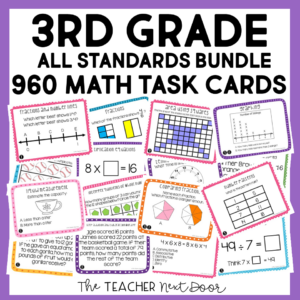
This 4th Grade Math Task Cards Bundle also has lots of word problems in almost every single of its 30 task card sets. These cards are perfect for centers, whole class, and for one on one.
CLICK HERE to see 4th grade:
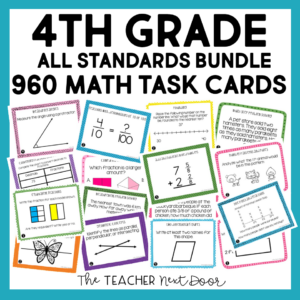
This 5th Grade Math Task Cards Bundle is also loaded with word problems to give your students focused practice.
CLICK HERE to take a look at 5th grade:
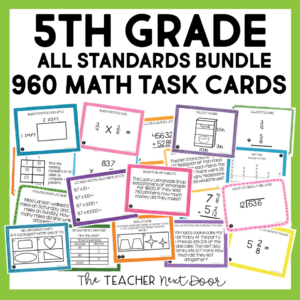
Want to try a FREE set of math task cards to see what you think?
3rd Grade: Rounding Whole Numbers Task Cards
4th Grade: Convert Fractions and Decimals Task Cards
5th Grade: Read, Write, and Compare Decimals Task Cards
Thanks so much for stopping by!


